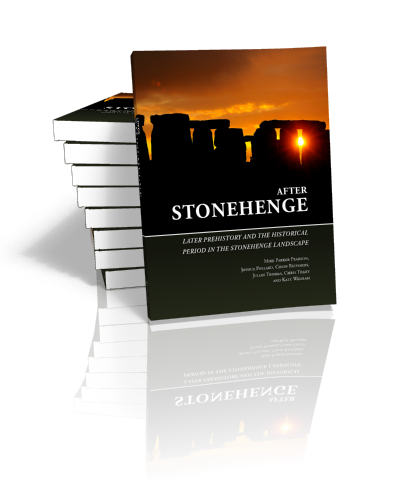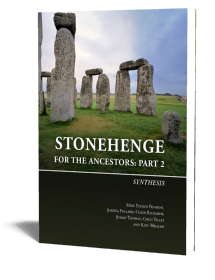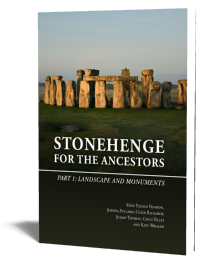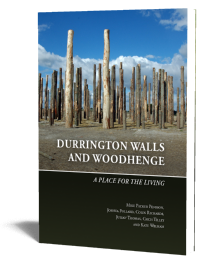After Stonehenge
Later prehistory and the historical period in the Stonehenge landscape
Mike Parker Pearson, Joshua Pollard, Colin Richards, Julian Thomas, Chris Tilley & Kate Welham | Forthcoming

After Stonehenge
Later prehistory and the historical period in the Stonehenge landscape
Mike Parker Pearson, Joshua Pollard, Colin Richards, Julian Thomas, Chris Tilley & Kate Welham | Forthcoming
Hardback ISBN: 9789088907128 | Imprint: Sidestone Press | Format: 210x280mm | ca. 275 pp. | The Stonehenge Riverside Project Volume 4 | Language: English | >50 illus. (bw) | >50 illus. (fc) | Keywords: Stonehenge, archaeology, prehistory, Neolithic, Britain, megaliths, mtone circles, mtanding mtones, Bluestone, Sarsen, avenue, landscape, Bronze Age, Iron Age, Roman period, Medieval period, Early Bronze Age, Middle Bronze Age, Late Bronze Age | download cover
Publication date: 2026
-
Digital & Online access
Digital/Online version not (yet) available
-
Buy via Sidestone (EU & UK)
This title is not yet available
-
Buy via our Distributors (WORLD)
This title is not yet available
-
Bookinfo
Hardback ISBN: 9789088907128 | Imprint: Sidestone Press | Format: 210x280mm | ca. 275 pp. | The Stonehenge Riverside Project Volume 4 | Language: English | >50 illus. (bw) | >50 illus. (fc) | Keywords: Stonehenge, archaeology, prehistory, Neolithic, Britain, megaliths, mtone circles, mtanding mtones, Bluestone, Sarsen, avenue, landscape, Bronze Age, Iron Age, Roman period, Medieval period, Early Bronze Age, Middle Bronze Age, Late Bronze Age | download cover
Publication date: 2026

We will plant a tree for each order containing a paperback or hardback book via OneTreePlanted.org.
For many centuries, scholars and enthusiasts have been fascinated by Stonehenge, the world’s most famous stone circle. In 2003 a team of archaeologists commenced a long-term fieldwork project for the first time in decades. The Stonehenge Riverside Project (2003-2009) aimed to investigate the purpose of this unique prehistoric monument by considering it within its wider archaeological context.
This is the fourth of four volumes which present the results of that campaign. It includes investigations of the monuments and landscape that succeeded Stonehenge and its remarkable complex of monuments. These later remains include circular burial mounds, known as round barrows, from the Early Bronze Age, as well as several Early Bronze Age cremation burials. Settlement remains from the Middle and Later Bronze Age as well as the Iron Age and Roman period are also covered. Finally, remains of Medieval and recent date were also encountered at various locations within the Stonehenge environs.
With contributions by:
Umberto Albarella, Mike Allen, Olaf Bayer, Wayne Bennett, Anna Bloxam, Duncan Brown, Martin Brown, Andrew Chamberlain, Ben Chan, Roger Doonan, David Field, Paul Garwood, Jennie Hawcroft, Rob Ixer, Carla Minniti, Douglas Mitcham, Elaine Morris, Alistair Pike, Derek Pitman, Richard Reece, Dave Robinson, James Rylatt, Dave Shaw, Ellen Simmons, Dan Stansbie, Anne Teather, Sarah Viner, Christie Willis and Ann Woodward
See the other volumes in the Stonehenge Riverside Project Series
LIST OF FIGURES
LIST OF TABLES
CONTRIBUTORS
PREFACE
ACKNOWLEDGEMENTS
1. Stonehenge and its round barrows
Round barrows in the landscape – (C. Tilley & W. Bennett)
Round barrows south of Woodhenge – (J. Pollard, D. Robinson & A. Pike)
The Bulford round barrow and cremated deposit – (C. Richards)
Grave goods from the Bulford barrow: chalk, stone, flint, crystal, worked bone – (J. Pollard, B. Chan, F. Roe)
The Cuckoo Stone cremated deposits – (C. Richards)
Bronze Age and later prehistoric pottery from the Cuckoo Stone – (A. Woodward)
Cremated human bones from the Cuckoo Stone and Bulford Early Bronze Age burials – (C. Cox Willis)
Lithics from Roman contexts at the Cuckoo Stone – (B. Chan)
2. The Bronze Age enclosure of Stonehenge’s landscape
The Stonehenge Palisade – (P. Garwood, J. Pollard)
The chalk pig from the Palisade – (A. Teather)
Bronze Age and later prehistoric pottery from the Palisade ditch – (A. Woodward)
Human bones from Iron Age deposits in the Palisade Ditch – (C. Cox Willis)
The Gate Ditch – (D. Robinson & O. Bayer)
Bronze Age and later prehistoric pottery from Amesbury 42 barrow, Bluestonehenge, Woodhenge, South of Woodhenge and Durrington Walls – (A. Woodward)
Lithics from the ploughsoil at the Palisade, South of Woodhenge and Durrington Walls (South Entrance) – (D. Mitcham)
Lithics from stratified contexts at the Palisade, Larkhill, West Amesbury (Bronze Age), South of Woodhenge and Durrington Walls (West Entrance) – (B. Chan)
Land boundaries after Stonehenge – (J. Pollard & P. Garwood)
3. Iron Age, Roman and later activity at Durrington Walls and environs
The Middle Iron Age settlement at Durrington: east entrance, interior and west entrance – (M. Parker Pearson, J. Pollard & J. Rylatt)
The Cuckoo Stone Roman building and burial – (C. Richards)
Roman pottery from the Cuckoo Stone, the Palisade, Amesbury 42 barrow, Larkhill, Aubrey Hole 7, Bluestonehenge, Woodhenge, South of Woodhenge and Durrington Walls – (D. Stansbie)
Roman coins from the Cuckoo Stone and south of Durrington Walls – (R. Reece)
Human bones from the Roman cemetery south of Woodhenge – (J. Hawcroft)
Post-Medieval quarrying at Durrington Walls – (M. Parker Pearson)
Later activity at Durrington Walls riverside – (J. Pollard)
4. West Amesbury medieval village
Medieval and post-Medieval pits and ditches at West Amesbury – (M. Parker Pearson)
Medieval pottery from West Amesbury – (D. Brown)
Human bones from a possible Saxon cemetery at West Amesbury – (A. Chamberlain)
5. Twentieth-century archaeology
Larkhill Army Camp – (J. Pollard)
Geophysics – (K. Welham)
Durrington west entrance WW1 deposits – (J. Rylatt & M. Brown)
The archaeology of archaeologists – re-excavating Cunnington, Hawley and Atkinson – (M. Parker Pearson et al.)
6. Environmental evidence and faunal remains
Land mollusca – (M. Allen)
Carbonised plant remains from the Palisade and West Amesbury – (E. Simmons)
Animal bones from the Cuckoo Stone, the Stonehenge Palisade, South of Woodhenge, Amesbury Riverside – (C.Minniti, U. Albarella & S. Viner)
7. Stonehenge: its architecture and its landscape: a reanalysis
C. Tilley, C. Richards, W. Bennett and D. Field
8. After Stonehenge: an overview
J. Pollard et al.

Prof. dr. Mike Parker Pearson
Mike Parker Pearson is Professor of British Later Prehistory at the Institute of Archaeology, University College London (UCL). He is a Fellow of the British Academy and has directed archaeological projects in Madagascar as well as in many parts of Britain. His books include The Archaeology of Death and Burial, Pastoralists, Warriors and Colonists and Stonehenge: investigating a Stone Age mystery.

Prof. dr. Joshua Pollard
Joshua Pollard is Professor of Archaeology at the University of Southampton. He is a leading authority on the Neolithic and Bronze Age in Britain, and is director of a major research project on the Neolithic stone circle complex at Avebury, where he has worked for many years. His books include Avebury: biography of a landscape, Landscape of the Megaliths and Avebury.

Prof. dr. Colin Richards
Colin Richards is Professor of Archaeology at the University of the Highlands and Islands in Scotland. He is a leading expert on stone circles and has excavated widely on Neolithic sites in Britain as well as on Easter Island and elsewhere in the Pacific. For many years he has been researching the Neolithic period in Orkney, where he is now based. His books include Dwelling among the Monuments, Building the Great Stone Circles of the North and The Development of Neolithic House Societies in Orkney.

Prof. dr. Julian Thomas
Julian Thomas is Professor of Archaeology at the University of Manchester. He is a leading expert on Neolithic Britain, and has directed excavations in many parts of Britain from Scotland to southern England. His books include Understanding the Neolithic, Time, Culture and Identity, and The Birth of Neolithic Britain.

Prof. dr. Chris Tilley
Chris Tilley is Professor of Anthropology at University College London (UCL). He has directed archaeological projects in Britain and has written widely on many topics including archaeological theory and phenomenology, for which he is known internationally. His books include A Phenomenology of Landscape, Metaphor and Material Culture, An Anthropology of Landscape and The Materiality of Stone.

Prof. dr. Kate Welham
Kate Welham is Professor of Archaeological Science at Bournemouth University. She has worked on projects in Britain, Kenya, Spain and Easter Island, and is a leading expert in geophysical survey as well as in archaeological materials. She is chair of the UK committee of archaeological heads of departments. She is co-author of Stonehenge: making sense of a prehistoric mystery.
Abstract:
For many centuries, scholars and enthusiasts have been fascinated by Stonehenge, the world’s most famous stone circle. In 2003 a team of archaeologists commenced a long-term fieldwork project for the first time in decades. The Stonehenge Riverside Project (2003-2009) aimed to investigate the purpose of this unique prehistoric monument by considering it within its wider archaeological context.
This is the fourth of four volumes which present the results of that campaign. It includes investigations of the monuments and landscape that succeeded Stonehenge and its remarkable complex of monuments. These later remains include circular burial mounds, known as round barrows, from the Early Bronze Age, as well as several Early Bronze Age cremation burials. Settlement remains from the Middle and Later Bronze Age as well as the Iron Age and Roman period are also covered. Finally, remains of Medieval and recent date were also encountered at various locations within the Stonehenge environs.
With contributions by:
Umberto Albarella, Mike Allen, Olaf Bayer, Wayne Bennett, Anna Bloxam, Duncan Brown, Martin Brown, Andrew Chamberlain, Ben Chan, Roger Doonan, David Field, Paul Garwood, Jennie Hawcroft, Rob Ixer, Carla Minniti, Douglas Mitcham, Elaine Morris, Alistair Pike, Derek Pitman, Richard Reece, Dave Robinson, James Rylatt, Dave Shaw, Ellen Simmons, Dan Stansbie, Anne Teather, Sarah Viner, Christie Willis and Ann Woodward
See the other volumes in the Stonehenge Riverside Project Series
Contents
LIST OF FIGURES
LIST OF TABLES
CONTRIBUTORS
PREFACE
ACKNOWLEDGEMENTS
1. Stonehenge and its round barrows
Round barrows in the landscape – (C. Tilley & W. Bennett)
Round barrows south of Woodhenge – (J. Pollard, D. Robinson & A. Pike)
The Bulford round barrow and cremated deposit – (C. Richards)
Grave goods from the Bulford barrow: chalk, stone, flint, crystal, worked bone – (J. Pollard, B. Chan, F. Roe)
The Cuckoo Stone cremated deposits – (C. Richards)
Bronze Age and later prehistoric pottery from the Cuckoo Stone – (A. Woodward)
Cremated human bones from the Cuckoo Stone and Bulford Early Bronze Age burials – (C. Cox Willis)
Lithics from Roman contexts at the Cuckoo Stone – (B. Chan)
2. The Bronze Age enclosure of Stonehenge’s landscape
The Stonehenge Palisade – (P. Garwood, J. Pollard)
The chalk pig from the Palisade – (A. Teather)
Bronze Age and later prehistoric pottery from the Palisade ditch – (A. Woodward)
Human bones from Iron Age deposits in the Palisade Ditch – (C. Cox Willis)
The Gate Ditch – (D. Robinson & O. Bayer)
Bronze Age and later prehistoric pottery from Amesbury 42 barrow, Bluestonehenge, Woodhenge, South of Woodhenge and Durrington Walls – (A. Woodward)
Lithics from the ploughsoil at the Palisade, South of Woodhenge and Durrington Walls (South Entrance) – (D. Mitcham)
Lithics from stratified contexts at the Palisade, Larkhill, West Amesbury (Bronze Age), South of Woodhenge and Durrington Walls (West Entrance) – (B. Chan)
Land boundaries after Stonehenge – (J. Pollard & P. Garwood)
3. Iron Age, Roman and later activity at Durrington Walls and environs
The Middle Iron Age settlement at Durrington: east entrance, interior and west entrance – (M. Parker Pearson, J. Pollard & J. Rylatt)
The Cuckoo Stone Roman building and burial – (C. Richards)
Roman pottery from the Cuckoo Stone, the Palisade, Amesbury 42 barrow, Larkhill, Aubrey Hole 7, Bluestonehenge, Woodhenge, South of Woodhenge and Durrington Walls – (D. Stansbie)
Roman coins from the Cuckoo Stone and south of Durrington Walls – (R. Reece)
Human bones from the Roman cemetery south of Woodhenge – (J. Hawcroft)
Post-Medieval quarrying at Durrington Walls – (M. Parker Pearson)
Later activity at Durrington Walls riverside – (J. Pollard)
4. West Amesbury medieval village
Medieval and post-Medieval pits and ditches at West Amesbury – (M. Parker Pearson)
Medieval pottery from West Amesbury – (D. Brown)
Human bones from a possible Saxon cemetery at West Amesbury – (A. Chamberlain)
5. Twentieth-century archaeology
Larkhill Army Camp – (J. Pollard)
Geophysics – (K. Welham)
Durrington west entrance WW1 deposits – (J. Rylatt & M. Brown)
The archaeology of archaeologists – re-excavating Cunnington, Hawley and Atkinson – (M. Parker Pearson et al.)
6. Environmental evidence and faunal remains
Land mollusca – (M. Allen)
Carbonised plant remains from the Palisade and West Amesbury – (E. Simmons)
Animal bones from the Cuckoo Stone, the Stonehenge Palisade, South of Woodhenge, Amesbury Riverside – (C.Minniti, U. Albarella & S. Viner)
7. Stonehenge: its architecture and its landscape: a reanalysis
C. Tilley, C. Richards, W. Bennett and D. Field
8. After Stonehenge: an overview
J. Pollard et al.

Prof. dr. Mike Parker Pearson
Mike Parker Pearson is Professor of British Later Prehistory at the Institute of Archaeology, University College London (UCL). He is a Fellow of the British Academy and has directed archaeological projects in Madagascar as well as in many parts of Britain. His books include The Archaeology of Death and Burial, Pastoralists, Warriors and Colonists and Stonehenge: investigating a Stone Age mystery.

Prof. dr. Joshua Pollard
Joshua Pollard is Professor of Archaeology at the University of Southampton. He is a leading authority on the Neolithic and Bronze Age in Britain, and is director of a major research project on the Neolithic stone circle complex at Avebury, where he has worked for many years. His books include Avebury: biography of a landscape, Landscape of the Megaliths and Avebury.

Prof. dr. Colin Richards
Colin Richards is Professor of Archaeology at the University of the Highlands and Islands in Scotland. He is a leading expert on stone circles and has excavated widely on Neolithic sites in Britain as well as on Easter Island and elsewhere in the Pacific. For many years he has been researching the Neolithic period in Orkney, where he is now based. His books include Dwelling among the Monuments, Building the Great Stone Circles of the North and The Development of Neolithic House Societies in Orkney.

Prof. dr. Julian Thomas
Julian Thomas is Professor of Archaeology at the University of Manchester. He is a leading expert on Neolithic Britain, and has directed excavations in many parts of Britain from Scotland to southern England. His books include Understanding the Neolithic, Time, Culture and Identity, and The Birth of Neolithic Britain.

Prof. dr. Chris Tilley
Chris Tilley is Professor of Anthropology at University College London (UCL). He has directed archaeological projects in Britain and has written widely on many topics including archaeological theory and phenomenology, for which he is known internationally. His books include A Phenomenology of Landscape, Metaphor and Material Culture, An Anthropology of Landscape and The Materiality of Stone.

Prof. dr. Kate Welham
Kate Welham is Professor of Archaeological Science at Bournemouth University. She has worked on projects in Britain, Kenya, Spain and Easter Island, and is a leading expert in geophysical survey as well as in archaeological materials. She is chair of the UK committee of archaeological heads of departments. She is co-author of Stonehenge: making sense of a prehistoric mystery.
-
Digital & Online access
Digital/Online version not (yet) available
-
Buy via Sidestone (EU & UK)
This title is not yet available
-
Buy via our Distributors (WORLD)
This title is not yet available
- Browse all books by subject
-
Search all books

We will plant a tree for each order containing a paperback or hardback book via OneTreePlanted.org.
You might also like:
© 2026 Sidestone Press KvK nr. 28114891 Privacy policy Sidestone Newsletter Terms and Conditions (Dutch)








